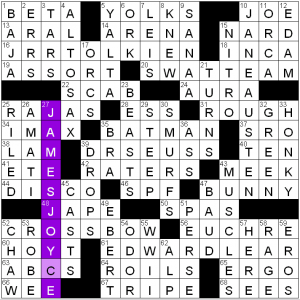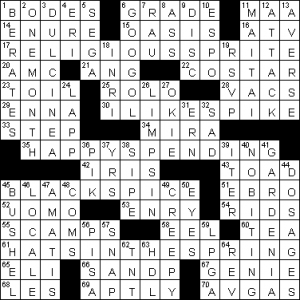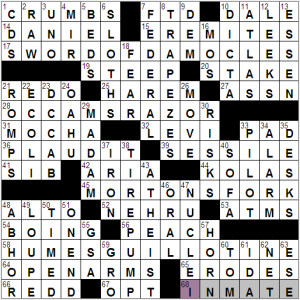NYT 6:37
LAT 5:54 (Gareth)
CS 4:27 (Sam)
CHE 5:07 (pannonica)
WSJ (Friday) tk (pannonica)
Joe Krozel’s New York Times crossword
Let’s take this one categorically.
First up, the category of The Woeful Crossing:
- 28a. [Matadors’ red capes], MULETAS. No cognates that I know of that help you get this if you happen not to have heard the term before.
- 28d. [___ Gerais (Brazilian state)], MINAS. This is also part of a Tolkien place name, Minas Tirith. What the heck are these two answers doing crossing at the M? Did you run the alphabet, plugging in random letters until the puzzle accepted your solution? Somehow I pulled MULETAS out of the cobwebs of my mind, but MINAS didn’t look at all familiar and I had zero confidence in it.
In case you were wondering, a Brazilian wax will run you $65 in Natick.
Grid: It’s asymmetrical and it has 18 blocks. I thought the deal with asymmetry in a themeless was, as in Frank Longo’s terrific Mensa Crosswords for the Super Smart, to attain heights in fill quality not possible with a symmetrical pattern. NOT WITH, MULETAS, MCMII, RATEL, INSANER, ELASTIN, MENISCI, TWO IN/BID IN, MINAS, RESAT, and TEN ONES are impressing, well, perhaps not no one, but not me. “The insaner guy resat at the auction and bid in with his ten ones?” I have said it before and I’ll say it again: I solve for the stuff in the white squares, not for the black squares. Call me crazy! But it’s called a crossword, right? The words are key. (Clarification: Actually, the grid has mirror symmetry along a diagonal rather than rotational.)
Art! 48a. [“Jazz” artist], MATISSE. I’ve always been fond of Matisse’s style. Jazz, a book of cutouts, is packed with pictures that pop.
The 15s: The grid is framed by eight 15s. RECAPITULATIONS and OVERESTIMATIONS are awkwardly plural and a little boring with the -ATIONS. IMAGINATIVENESS isn’t a roll-your-own word, but feels like one. LOVE ME OR LEAVE ME is terrific and gets a clue that was foreign to me: 15a. [Doris Day film with the song “Ten Cents a Dance”]. 17a: [Peoria resident’s representation] clues AVERAGE AMERICAN, which is all right. 2d: [1991 entrant for the Democratic presidential nomination], GOVERNOR CLINTON … I guess that works too. STOOD ON ONE’S TOES is a ONE’Sie; okay, but the ONE’S part is meh. Not sure the AGAINST part of CONNIVES AGAINST is properly “in the language” rather than just a preposition that can go with a particular verb.
Biggest groaner: 32d. [“Does the name Quasimodo ring a bell?,” e.g.], GROANER.
Fill I liked: PINE NUT, GUNKY above BLOBS, PUEBLOS, FUNKS, INIMICAL.
Number of stars: 2.5.
Raymond Hamel’s CrosSynergy/Washington Post crossword, “Neologisms”- Sam Donaldson’s review
Today’s puzzle honors the authors behind five “neologisms” (or “newly-coined words”). I knew none of the answers based only on the clues, but needed just a few crossings for them to fall, as all of the writers are very well known. Did you know these fun facts:
- 16-Across: J.R.R. TOLKIEN is the [Fantasy writer who coined the word “tween”], thus substantiating my theory that Miley Cyrus is an orc.
- 39-Across: DR. SEUSS is the [Children’s author who coined the word “nerd”]. I will not eat them with a herd, I will not eat them with a nerd.
- 61-Across: EDWARD LEAR is the [British poet who coined the term “runcible spoon”]. I’ll just assume that’s interesting, as I’m not familiar with runcible spoons. Oh, alright, I’ll look it up. My dictionary says it’s a “three-pronged fork, such as a pickle fork, curved like a spoon and having a cutting edge.” Happy now?
- 10-Down: JANE AUSTEN is the [British novelist who coined the term “dinner party”].
- 27-Down: JAMES JOYCE (or was it Joyce James?) is the [Irish writer who coined the word “quark”]. I had no idea he was a Deep Space Nine fan. (You’re welcome, three people who got that joke.)
Past puzzles to the rescue! Tony Orbach’s last CS puzzle reminded us that the ALTO SAX was [Charlie Parker’s instrument], and it wasn’t that long ago we saw SANAA, [Yemen’s capital]. I grew up knowing a [Mouthful of tobacco] as CHEW, not CHAW, but the crossing ABCS saved me. Had nearby crossings been harder, I would have stewed over HOYT Wilhelm, a Hall of Fame pitcher known for his knuckleball and for being the first reliever to notch 200 saves.
The theme required a lot of Js in the grid (four of them, by my count), so we saw the usual suspects when it came to J-words: BAJA, RAJAS, JAPE, JOE. We also saw some common crossword friends like the ARAL Sea, an INCA, ESS, ETE, and so forth. But there was also a good amount of lively stuff like CROSSBOW, SMURFS, YOLKS, HONKY, and DISCO. That the grid can be this smooth given all the rare letters is quite a constructing feat.
Favorite entry = SWAT TEAM, the [Police unit]. Favorite clue = [They’re taken in checkers] for TURNS.
Jack McInturff’s Los Angeles Times crossword — Gareth’s review
Straight-over-the-plate letter edition theme from Jack McInturff today, SANDP (SP) are added to the beginnings of the final answers of four phrases: RELIGIOUS(SP)RITE, ILIKE(SP)IKE, HAPPY(SP)ENDING, BLACK(SP)ICE and HATSINTHE(SP)RING. My faves are the ones that go beyond just two word answers, viz ILIKESPIKE and HATSINTHESPRING.
Big corners today for such a dense theme! Mostly they work: I didn’t know DULCINEA, but then I haven’t read Don Quixote… Still a good entry! NOBITING was, even more than the theme, the highlight of the puzzle for me. Unexpected!
Apart from DULCINEA, there were a few other unknowns for me today. I’m venturing [Airport near a Gt. Lake], ERI refers to Erie, Pa: YES! I only know “Eri Tu” from crosswords, but I reckon it’s a good couple of orders of magnitude better as a clue. SIPE is also way out of my knowledge base, that’s a goofy surname right there! Author RAU and LES Aspin in Clinton’s cabinet also required all the crossings! Regular crossword-solvers probably had no trouble with ITER and EBRO, but I can see a newbie having a blank square there!
Let’s see… 3.5 stars? Gareth out.
Mark Feldman’s Chronicle of Higher Education crossword, “Sharp Philosophy” — pannonica’s write-up
One generally thinks of philosophers having sharp minds, acute intellects. This puzzle’s theme means to put teeth to that notion, highlighting four philosophical concepts that have a certain tang.
- 17a. [Constant and imminent peril] SWORD OF DAMOCLES, which I frequently take one step further, imagining a double-edged sword of Damocles.
- 28a. [Principle that the simplest explanation is usually the correct one] OCCAM’S RAZOR. I learned about this concept about the same time as the “serious” component of Bill Murray’s acting career began, in a film version of W Somerset Maugham’s The Razor’s Edge (1984). As a result, all three are permanently conflated in my mind, thus ensuring that I will have difficulty discerning the simplest explanation of anything.
- 45a. [Set of two contrary opinions that lead to the same unhappy conclusion] MORTON’S FORK, which I hadn’t heard of but heartily endorse.
- 58a. [Impossibility of reconciling what is and what ought to be] HUME’S GUILLOTINE. Ah, another ray of cheershine. Philosophy can be a gloomy biz.
Of the four, I feel the guillotine and the razor are unequivocally sharp, the sword not necessarily so, and the fork even less guaranteed to be (it’s more of a strength-in-numbers implement), but the point is well-taken.
Along the way, we’re treated to some stylish fill, notably the longish TRAPEZES, TIRE PUMP, OPEN ARMS [insert Journey YouTube link here], EREMITES. PLAUDIT, and SESSILE.
Bons mots:
-

Yukon International, from South Africa, of course.
Symmetrical pair of MOCHA ice cream and KOLAS, the [Caffeine-rich nuts].
- 12d [Vichyssoise vegetables] LEEKS. I am thoroughly enamored with baby leeks. Pricey, but so tasty, and minimal rinsing required.
- Second-most amusing wrong answer: 26d [“You’re in my seat!”] MINE, rather than MOVE.
- Round-up of question-mark clues:
- 34d [Early buzz?] ALARM – meh.
- 38d [What’s needed if you’re not feeling enough pressure?] TIRE PUMP – eh.
- 43d [Unfaithful one?] ATHEIST – ah.
- 47d. [Scientific centers?] NUCLEI – good!
- 46d. [Degree candidate’s hurdle] ORAL. Less stressful than the alternative, I should imagine.
- 55d. [World Thinking Day org.] GSA. I looked to Wikipedia for a list of GSA organizations and was unable to assess which one it might be: the Genetics Society of America, the Geological Society of America, the German Studies Organization, the Gay-Straight Alliance, the Girl Scouts of the USA, the German Scholars Agency, or the Gerontological Society of America. It was the Girl Scouts.
- Most amusing wrong answer: 68a [Resident unable to leave] INTERN, not INMATE.
Good, fact-imparting puzzle.




This is one of the few times that growing up overseas has worked in my favor; MINAS Gerais was a welcome gimme because I’ve lived in Brazil. It helps make up for the many US-centric ’60s pop-culture references I completely miss.
Oh yeah, no idea whatsoever on the M (and lucky I didn’t make more mistakes elsewhere). The grid looks nice and all, but not a fun solve.
What do I know, but I was impressed with the NYT puzzle. Felt fresh, thought the long answers were good, especially IMAGINATIVENESS. Few letters I couldn’t get due to my limited vocabulary and knowledge but that happens. Amy’s the pro but the review seemed overly harsh.
MINAS was a gimme for me since our family hosted a Brazilian exchange student from there. The comet is HALLEY’s comet, not HALEY’s comet, so 23D should have been clued as “Alex who found his roots?”
Never heard of CELESTE frozen pizza, and had to Google for it as well as for 8D (OLMOS) and 31A (MCMII). Never heard of MULETAS or TRE corde or NIT as a bird either but got them from the crosses.
The clue is for Bill Haley and the Comets of Rock Around the Clock fame.
I’m generally a JK fan, and I do appreciate wide open grids in moderation. By pushing the boundaries of “acceptable” fill they require you to open your mind to more potential answers than in, say, a snappy Quarfoot 72-worder, and often the combination of wide-open spaces and tricky clues necessitates logical and constraint-satisfaction-type thinking as opposed to just trivia recall and pun parsing; sometimes you feel like you’re filling the grid right along with the constructor. Plus, they tend to feature interesting long answers and they challenge constructors.
Yet I hated this puzzle.
Why? Because there wasn’t a lot of fun to be had. Instead of fun, novel 15s, we got single word answers with a bunch of suffixes and contrived phrases. Instead of creative stretching of the English language, we got 7-letter partials. The cluing felt unfair for a friday, also, but there were no great “of course” moments when I cheated on answers that stumped me (yeah, DNF here). Plus, this grid doesn’t raise the bar for constructors; it felt unnecessary. I already know that Krozel can fill grids just as and more open than this much more smoothly. If a constructor is going to take so many liberties with the fill, I at least hope that it’s in service of a record-setting grid or at least a new type of layout; we’ve seen this 8×15 with diagonal rows of blacks layout done much better, so this grid offers nothing to the repertoire.
Anyway, I usually avoid the comment section when grids like this come around because they tend to get unduly acerbic, but I felt that as a disappointed fan of JK and grids like this I should weigh in.
Well, it’s a funny world. I thought that this was not only a tour de force, but a remarkably creative different, challenging, enjoyable solve. I am spectacularly not into bull fighting, but the muleta is a term that one encounters in pretty much any discussion of the unpalatable subject. (Like the toro, the corrida, a veronica, etc.)
Una corda (one string) tre corde (three strings). Most piano tones are produced by the simultaneous, sympathetic vibration of three strings (except at the top and bottom of the range.) The una corda (“soft”) pedal displaces the hammers slightly to the right, allowing the hammer to strike only one of the three strings, thereby producing a sound which is yes, somewhat softer, but more to the point, different in timbre and texture, less resonant. (A famous marking was where Ravel called for the pianist to play “una corda, fortissimo.”) I guess anything music related which not a rapper, rock group, or Ned Rorem calls for censure.
Insaner is a bit weak, and I don’t understand “tera” as a lead in for flop, but I thought the puzzle was fantastic.
I believe the “flop” is a floating-point operation in computing.
Bruce, that’s a nice summary of that particular topic of pianism. What is the Ravel piece you mentioned? For this answer I began with only the last “e” because I wasn’t sure if it would be TRE corde or the more rare (but not unheard of) due corde (two strings). There is a passage in Beethoven’s Hammerklavier sonata which, paraphrased into English, reads “play one string–slowly progress to two strings and finally three strings”–you need a well-controlled left foot to pull that off!
The Ravel reference is to the end of Scarbo — that great spot where the main, soaring motif D#, E D# (an octave higher) recurs.
Yes, in the Hammerklavier, there are fascinating una corda, tre corde detailed markings. They are most prevalent in the Ricordi edition, edited by Alfredo Cassela; and many scholars believe that this edition most closely reflects Beethoven’s wishes and performance practices. At the end of the astounding, slow movement, for example, the beginning of the last line of music is marked ‘p’ una corda, with a big decrescendo from ‘p’ to ‘ppp’ on the last F# Major chord. BUT — that chord is marked ‘tre corde’. So he wants a barely audible pianissimo, with very low notes in the left hand, impossible for some hands to play without arpeggiating (though he marks it “senza arpeggio”), but he wants the richness of the 3 strings. Who ever said the life of a pianist would be easy. In fact, my favorite marking in the Hammerklavier is the way he keeps writing in the Fugue “Senza Affrettare.” If someone can tell me how to play that fugue without fretting, I’ll be happy to listen. :-)
Bruce, you’re paranoid! There was no “censure” of TRE corde. All James P. said was that he didn’t know the term but got it from the crossings, and I was mum on the word.
I’m generally on the positive side for today’s NYT… Quite a bit of good fill, e.g., CONNIVE is a great word. Admittedly, the some of long words weren’t so great, MULETAS is somewhat obscure but not out of line, IMO– the initial ‘M’ was a guess for me, but it was the first and only letter I tried. But I give some credit for technical achievement, so 3.5 astri from me.
One thing I do love about these puzzles is that no matter what the clue/answer, there are always solvers that know it immediately, based on their life experience.
Now although I have some limited Spanish language experience (conjugation/vocab, simple communication and cursing, etc. The basics), MULETAS / MINAS was one of the more “insaner” crosses I’ve seen. Not particularly fair, even considering the constraints of the puzzle. I am not surprised that some people are very familiar with the Brazilian state. It’s a small world, after all :). And that’s a good thing to see.
I did enjoy traveling through the remaining grid, though. Considering the amount of space involved, the clever cluing eased the long journey.
“One thing I do love about these puzzles is that no matter what the clue/answer, there are always solvers that know it immediately, based on their life experience.”
There’s an idea — henceforth, all ACPT entrants will just form one large team.
And yet we’d still finish slower than Dr. Fill.
perhaps — but (at this stage of the game…) we might stand a better chance of submitting a 100% perfect puzzle!
;-)
I’m another. Didn’t know MULETAS, but was familiar with MINAS Gerais from composing species distribution maps and general research. I don’t feel it’s a “killer” crossing, not for a Friday. Also, just in case anyone is wondering, I am in no way affiliated with mnemonica.
Thanks for the clarification on Haley/Halley, RK. Subtle, that.
I’m sure that many solvers knew MULETAS and/or MINAS, and it wasn’t a killer crossing for them, but as far as what should be allowed on a Friday (or any day), I make a more categorical distinction than you, pannonica. In my opinion, if both sides of the crossing rely strictly on trivia—that is, if one don’t know the exact answer, then he can’t make an educated guess—the crossing should be ruled out on principle. (An exception can perhaps be made for trivia that’s judged to be common knowledge, but even that is not ideal.)
Will Shortz is usually very good about providing the basis for educated guesswork if necessary, but he fell down this time. I commented below, saying how the clues for these words might have been improved.
MINAS was my first sure entry because I hail from those parts, but MULETAS I am sorry to say stopped me because they are not the red capes, but the sticks on which the capes are carried and waved. A MULETA is in non-bullfight useage a “crutch,” the stick that supports a person with a broken ankle. As for NIT I’d sure like a reference.
Dave, thanks for the “flop” explanation.
2grouse intransitive verb
groused, grous·ing
: complain, grumble
(m-w)
Chiming in to concur with the general consensus about MULETAS/MINAS: it was a poor crossing: unguessable unless you know one of two specific bits of trivia. Very unusual to see that in the NYT crossword.
As it happens, I finally settled (very tentatively) on guessing M for that crossing, so I ended up getting lucky there. Was tripped up by a different crossing, though—ELAStIN/tRE, where I put an E for the T. However, that one gets a pass, as shrewder guesswork on my part would have gotten it. TRE CORDE is difficult, if you don’t know the term, but still somewhat surmisable if you’ve seen the inside of a piano and you know how the pedals work, and you think about cognates of TRE and CORDE. ELASTIN is easier—the hint was planted with the word “Pliable”, and I entirely missed it.
That’s the sort of careful cluing I’m used to seeing from the NYT, which is why it’s the only puzzle I do on a regular basis. The cluing of MULETAS/MINAS is a rare stumble for Will Shortz. Looking up the etymologies of both words, I think that both clues might have been improved on. MULETAS is difficult, because, as Amy points out, there’s no obvious English cognate. It turns out it comes from “mule”, and essentially refers to the stick bearing this cape, so perhaps it could have been clued as something like The cape-bearing stick wielded by a matador in the final third of a bullfight.
MINAS is easier: “___ Gerais” (Brazilian state known for its iron, gold, and gemstone reserves)” —et voilà! you now have a basis for guessing the M.
PS- just noticed I made a second mistake, at the crossing of MEnISCI/nIT (had TIT instead). That’s another tough one.
Pannonica, if the”grouse” clue had ended in a “?” it would have been a giveaway, so I was the one fooled. Thank you. Again to mention MINAS, if the Geography clues are known entities, they are smeared as crosswordese, so the editor/constructor can’t win.
What do you make of ELAN, clued as “Life” in the LAT? Flare, eagerness, style, is the way I understand the word. Is it ELAN or ÉLAN?
Is it short for “elan vita”, which still doesn’t mean life, per se, but rather, “creative force”? I suppose that could be a loose connotation, but we’re a far way from ELAN=”Life”.
Not “elan”, but “life” is being used in one of its extended senses (sense 13. here).
Gareth: DULCINEA
Actually, BID IN is a totally legit phrase… if anyone’s interested:
From my iPhone dictionary app:
14. bid in, Com. to overbid all offers for (property) at an auction in order to retain ownership.
(It’s a very good and comprehensive free app too)
-MAS
Would it have been better to clue BIDIN as [1930 Gershwins song, “___ My Time”]?
That 18-block grid *is* symmetrical, just not centrally symmetric as we’re used to. Try reflecting about the NW-SE diagonal. Remember the Saturday puzzle of some years ago (found it on xwordinfo: February 21, 2009, by Nothnagel and Walden) that not only had this symmetry but also used it to clue SYMMETRIC_MATRIX?
Surprised to see all this discussion of “TRE corde” but nothing about musical RECAPITULATIONS. Maybe if this puzzle ran on a Saturday it would clue that word via sonata form.
NDE
Hey! That’s what I said yesterday: “(Clarification: Actually, the grid has mirror symmetry along a diagonal rather than rotational.)” #iknowsomemathtoo
Sorry, I somehow missed that and had to find it on the present page with Google!